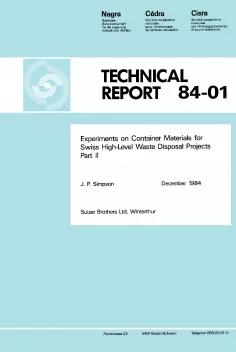
Technical Report NTB 84-01
Experiments on Container Materials for Swiss High-Level Waste Disposal Projects Part II
The present concept for final disposal of high-level waste in Switzerland consists of a repository at a depth of 1100 to 1150 m in the crystalline bedrock of northern Switzerland. The waste will be placed in a container which is required to function as a high integrity barrier for at least 1000 years.
This report is the second of a set of two dealing with the evaluation of potential materials for such containers. Four materials were identified for further evaluation in the first of these reports; they were cast steel, nodular cast iron, copper and Ti-Code 12. It was concluded that some testing was needed, in particular with respect to corrosion, in order to confirm these materials as candidate container materials.
The experimental programme included:
- corrosion tests on copper under gamma radiation
- immersion corrosion tests on the four candidate materials including welded specimens
- corrosion testing of the four materials in saturated bentonite
- constant strain rate testing of Ti-Code 12 and copper at 80ºC
- the behaviour of copper, Ti-Code 12 and Zircaloy-2 when immersed in liquid lead
- corrosion potential and galvanic current measurements on several material pairs.
The standard test medium was natural mineral water from the Bad Säckingen source. This water has a total dissolved solids content of approx. 3200 mg/l, about 1600 mg/l as chloride. The oxygen level was defined as 0.1 μg/g. In certain cases this medium was modified in order to test under more severe conditions.
The results of the corrosion tests confirm in general the evaluation in the first part of the report. All of the materials are suitable for high-level waste containers: cast steel, nodular cast iron and copper as single layer containers, and Ti-Code 12 as an outer corrosion resistant layer. Copper could also be used under an outer steel layer, where it could arrest local penetration.
The corrosion rate of the iron base material under standard test conditions decreases rapidly over the first 500 hours; it is higher at 80°C than at 140°C. Corrosion rates of under 10 μm/year were measured on cast steel at 140°C over 6,000 hours, and 34 μm/year at 80°C over 1400 hours. For the time interval 500 -1440 hours at 80°C a corrosion rate of under 10 μm/year was estimated. Localized attack was not observed. It was concluded that a corrosion allowance of 20 μm/year is adequate for cast steel and nodular cast iron.
Copper was confirmed as a suitable container material. Copper specimens corroded as fast as oxygen was supplied; no localized corrosion was observed, and no other effective corrosion mechanism was identified. Radiation levels equivalent to 30 mm of copper shielding had no significant effect on the corrosion behaviour of copper.
Bentonite did not affect the corrosion behaviour of any of the four materials at 140°C at test periods of up to 400 hours.
The constant strain rate tests confirm that Ti-Code 12 and copper are resistant to stress assisted cracking under repository conditions.
Copper, Zircaloy-2 and Ti-Code 12 are not adversely affected by molten lead; the use of molten lead to fill the internal cavity of the container remains an option since copper, Ti-Code 12 and Zircaloy-2 are resistant to molten lead at 350°C.
The chemical analyses of groundwaters carried out in the course of the Nagra geological programme show that the standard water composition used for the present study is significantly less saline and also more oxidising than Swiss groundwaters in crystalline rock at depths between 1000 and 1500 m (total salinity typically 15000 mg/l, virtually oxygen free). The corrosion behaviour of the four materials tested here is nevertheless expected to be very similar in such groundwaters. Immersion corrosion tests and corrosion tests in bentonite have been started in order to verify experimentally this hypothesis.
